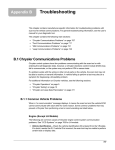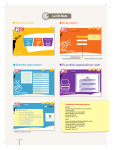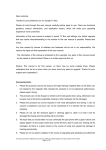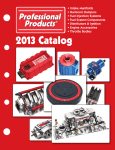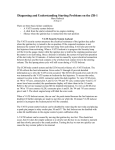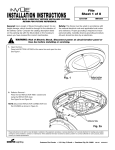Download installation of large bore 670 cfm tbi on late model gm engine
Transcript
6201 Industrial Way * Marine City, MI 48039 * Phone 8107655100 * Fax 8107651503 INSTALLATION OF LARGE BORE 670 CFM TBI ON LATE MODEL GM ENGINE (19871995) OR OTHER V8 ENGINES Installing a Holley 670 CFM or GM 454 large bore TBI unit is a popular performance upgrade for V8 TBI or carbureted engines. INTAKE MANIFOLD – If you are installing this TBI on a production TBI 2 barrel inlet manifold we recommend that you bore the openings below the TBI out to match the bore size of the 670 Holley or GM TBI. At the very least you should taper the openings down about ½” to achieve a smooth airflow below the TBI and maximum performance. You can accomplish this with a rotary file and a die grinder if you are careful, plug the manifold with rags below where you are grinding and clean up any filings with a vacuum after you are finished. If you choose to use a 4barrel intake, Howell Engine Developments can supply you a suitable adaptor to go with the TBI unit. Make sure you have adequate vacuum taps on the manifold and a tapped hole that will accept the EFI coolant sensor in the front water crossover. FUEL LINES – Production GM fuel lines will connect directly to the 670 TBI, using the metric fittings from any GM TBI unit, or we may have supplied hose nipples at your direction for the fuel connections. The fuel fitting on the driver (left) side is fuel in and the one on the right is return fuel to the fuel tank., VACUUM LINES – Connect all vacuum lines as on a production TBI except for the MAP vacuum on the Holley unit. DO NOT USE THE FITTING ON BACK OF HOLLEY TBI FOR MAP VACUUM. Instead use one of the full time vacuum ports on either side at front of TBI unit. You can use the rear fitting for some other full time vacuum line, but since it comes off the idle air passage inside the TBI, it gives a false signal at idle and part throttle and upsets the EFI calibration. EMISSION CONTROLS – The EPA would prefer that you run an emission legal vehicle and we recommend that you continue to use the emission controls and catalytic converter that came on your vehicle. Realistically, if you have modified your engine for performance in other areas such as a bigger camshaft, different cylinder heads, larger displacement and exhaust headers it is probably no longer emission legal and adding the 670 TBI unit won’t make it more or less legal. In the event you are using a camshaft with more than production duration and overlap, you probably no longer need EGR and running the EGR valve will aggravate the rest of the calibration. You should be aware of the local emission requirements and know what you are risking with your modifications. 1 6201 Industrial Way * Marine City, MI 48039 * Phone 8107655100 * Fax 8107651503 Howell Engine Developments accepts no liability for your emission compliance unless we agree ahead of time to help you achieve compliance on your installation. THROTTLE CABLE – You should be able to use your production throttle cable and cable brackets. If you are using the GM 454 TBI, you may need to modify the throttle lever to accommodate any transmission cables in your vehicle. Contact Howell Engine Developments if you need assistance in this area. AIR CLEANER – You may use your production air cleaner assembly or a suitable aftermarket one. GM sometimes retains the air cleaner with a single center stud and sometimes two bolts coming off the TBI hold down bolts on either side. If you buy a new air cleaner be sure it has the correct matching hold down bolt pattern. Most production air cleaners now supply cold or ambient air to the TBI rather than under hood air. You should be aware there is a 1% loss of power for every 10degree rise in TBI air temp, so changing to an open element air filter is not always a power gain. Never run your TBI engine without the air cleaner (even on the drag strip) as this upsets the mixture distribution and is a significant power loss. ELECTONIC MODIFICATIONS ADAPTING TO THE HOLLEY TBI CONNECTORS – The Holley TBI has its own 4pin injector harness connector and the early (19871990) throttle position switch (TPS). If you are installing on a 1991 or later GM vehicle Howell’s will supply you the correct 3pin TPS connector that must be spliced into your factory wiring harness. Uncover the TPS branch and clip off the small round 3pin TPS connector from your vehicle harness. Splice together and solder the blue, black and gray wires to the matching color on the wide 3pin TPS connector for the 670 TBI. Insulate the soldered splices individually with black electricians tape and recover them with the factory split nylon covering. INJECTOR CONNECTORS, HOLLEY ONLY – Separate and uncover the TBI injector leads in front of the TBI unit. Cut off the 4 factory wires to the production TBI injectors and 6” below the rubber sealing grommet in the air cleaner flange. Theses wires will be blue, green, red and white. Both red and white wires are constant 12V supply when the ignition key is “on”. Strip all 4 cut off vehicle harness wires and the 4 wires from the 670 injector connector at least ½” for splicing. Twist and solder together each matching color pair of wires and tape insulate them form each other. Rearrange the wires in the vehicle harness to proved a smooth trunk and retape in their new location. Replace the splitribbed conduit over the modified section. This completes the wiring harness mods. 2 6201 Industrial Way * Marine City, MI 48039 * Phone 8107655100 * Fax 8107651503 CALIBRATION PROM AND ECM To complete the electronic system you need to replace the calibration prom or Memcal in your vehicle ECM with the special 670 calibration supplied by Howell Engine Developments. In trucks the ECM is located in the upper right hand corner of the instrument panel. It is necessary to remove the glove box to gain access the ECM. It is not necessary to remove the glove box door. 1. After removing the glove box, slide the ECM to the left, this will release it from its mounting bracket. Depress the latches and remove the harness ECM connectors, one at a time, form the ECM. The ECM can now be removed from the glove compartment hole. 2. Remove the ECM cover (retained by two screws). 3. Remove the larger of the calibration proms by carefully prying and lifting it straight up. (To remove Memcals, release the latch on each end and lift out.) 4. Install the supplied Howell Performance calibration prom or memcal. It will only go in one way, so it can’t be installed wrong. Replace the cover. 5. Reverse the removal sequence and reinstall the ECM in its vehicle mounting. You may want to start up the vehicle before buttoning up the glove box area (just in case). CAUTION : Do not remove the calprom with the harness still connected to the ECM. It may be damaged by 12V power that is always present in the vehicle harness when the battery is connected. INITIAL VEHICLE STARTUP AND OPERATION With calibration prom and TBI in place the vehicle should be ready for startup. When ignition key is first turned on, listen for fuel pump operation. It should turn on for 2 to 3 seconds and then the ECM will turn it off until you engage the starter. The first time the ignition is turned on may not be a sufficient amount of time to fill the TBI and fuel line with fuel. Cranking for a few seconds should complete the filling. The engine should start up and smooth out after a few seconds to purge air form the injectors. Check for fuel leaks and make sure none of your altered wiring or fuel lines are in a position that the exhaust system heat may damage them. MAKE SURE THE COOLING SYSTEM IS FULL. INITIAL DRIVING IMPRESSIONS The calibration prom supplied with your 670 TBI is based on several years of driving and dyno testing experience. It should be a good match for your engine. However the GM ECM has the ability to reprogram and develop a new program to match your engine exactly. It does this by reading information from the Oxygen sensor and 3 6201 Industrial Way * Marine City, MI 48039 * Phone 8107655100 * Fax 8107651503 correcting the calibration until it matches GM’s original intent. It will keep this new program in its memory as long as the battery is connected and charged. If you disconnect the battery, the ECM will loose the learned program from memory and go back to the original Howell program. However, it will immediately start learning again as soon as you start driving the vehicle and it is warm enough to go into closed loop. This learning ability applies to part throttle only. Any changes to wide open throttle fuel must be done by recalibration or change in fuel pressure. All of your vehicle emission controls, knock sensor and oxygen sensor are still functional as designed by GM. All of your diagnostics and sensor default features still function with the 670 calibration. Any electronic or engine control problem can still be diagnosed by a GM dealer or tune up shop using their computer diagnostic equipment that plugs into the under dash ALDL connector. Our service manual also gives techniques for “doityourself” diagnostics using a jumper, the ALDL connector and the “service engine soon” light on the instrument panel. TUNING ADJUSTMENTS One feature of the Holley 670 TBI that is not available from GM is an adjustable fuel pressure regulator. It is located behind the injectors and can be adjusted using a 5/32” Allen wrench. Our calibration prom was tailored to your engine power and may require a higher regulated pressure than your factory intank pump can supply. In case you need more fuel pressure you may need to replace your intank pump with a 19941995 454 truck intank pump. These engines were calibrated at 20 PSI so they have a higher capacity pump. You can also use a 1990 Camaro TPI intank fuel pump. To determine whether you have and can maintain adequate fuel pressure at Wide Open Throttle, you may have to tee in a temporary fuel pressure gauge you can tape to the hood of your vehicle during initial testing. Your fuel pressure should not vary more than 1 PSI between idle and WOT. This is an extremely important test, particularly if you have a modified engine that requires more fuel than the stock original engine. Reprogramming the calibration prom cannot compensate for a varying fuel pressure. Under normal conditions you should not have to adjust fuel pressure. You may want to optimize wideopen throttle power or lean down for maximum fuel economy towing. You can do this with the built in adjustable regulator on the Holley 670 unit. NOTE : Be aware that leaning out an engine under heavy loads can shorten engine life by increasing the running temperature of pistons, valves and exhaust manifolds. Unlike GM, we don’t prevent your tampering with fuel pressure, therefore we can’t warranty your engine if you get into trouble. BECAUSE THE HOLLEY TBI UNIT HAS ADJUSTABLE FUEL PRESSURE we will not be responsible for any damage to your engine from rich or lean operating conditions. No guarantee is expressed or implied by 4 6201 Industrial Way * Marine City, MI 48039 * Phone 8107655100 * Fax 8107651503 Howell Engine Developments for the rest of your engine, only our parts are guaranteed. If you feel you need to do serious tuning or recalibration work for your application, contact us at 8107655100 and we will work with you on a new calibration together. Adjustment of the throttle closed stop screw may be required to tailor the 670 TBI to your application. To accomplish this properly use the following procedure: 1. Jumper across the “A” and “B” pins of the ALDL connector (the black and white wires) using a jumper or paper clip. 2. Turn on the ignition but do not start the engine. This will close the Idle Air Control pintle. 3. Disconnect the Idle Air Control connector at the TBI and remove the ALDL jumper. 4. Start the engine and set a minimum idle speed that will keep the engine from stalling. 5. Turn off the engine and reconnect the IAC connector at the TBI. The IAC motor should now control a warmed up engine in neutral just slightly off its closed position. This will also give you a range of higher idle speed for cold starts and a minimum idle that will keep the engine from stalling when coming up to a stop sign or light. If you moved the throttle stop screw more than half a turn, reset the closed TPS voltage to .5 .6V as measured with a voltmeter between the dark blue and black wires on the TPS connector. Rev 2215 BH 5








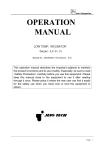
![ACTIVALL - Instrukcja Obsługi_EN [w5] - Akces](http://vs1.manualzilla.com/store/data/005768844_1-d053a11c07508a5544c783645c43d650-150x150.png)
